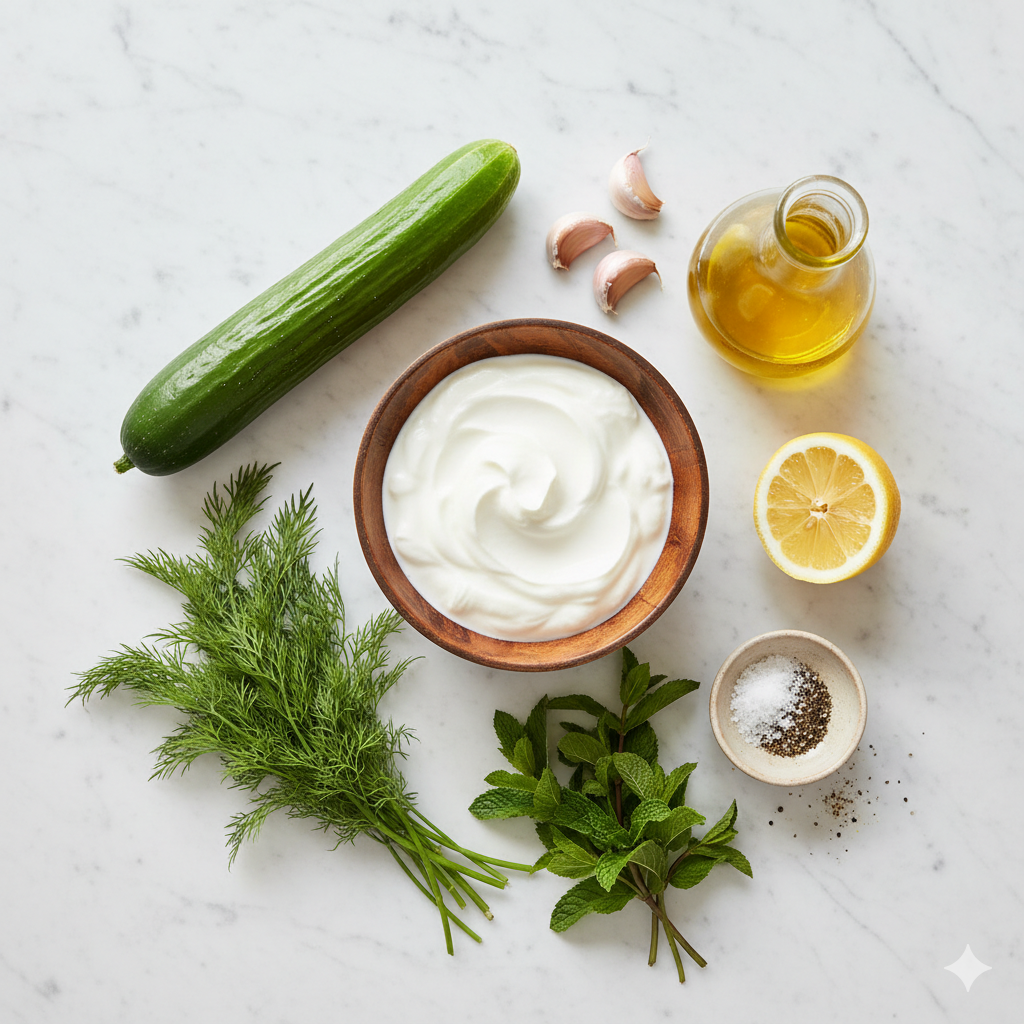If you’re looking for a refreshing, creamy, and healthy dip that instantly transforms ordinary snacks and meals into a Mediterranean delight, then you need to meet Tzatziki.
This cool yogurt-and-cucumber sauce has become a favorite in American kitchens — perfect as a dip for pita bread, a sauce for grilled meats, or even a light dressing for salads and grain bowls.
In this detailed guide, we’ll explore everything about Tzatziki — its Greek roots, why it’s so healthy, step-by-step instructions, expert tips, variations for every lifestyle, and how to serve it like a pro.
Table of Contents
What is Tzatziki?
Tzatziki (pronounced: tsah-TSEE-kee) is a classic Greek dip made with:
- Thick Greek yogurt
- Freshly grated cucumber
- Garlic
- A splash of lemon juice or vinegar
- Extra virgin olive oil
- And a sprinkle of fresh herbs like dill or mint
The result is a creamy, tangy, and slightly garlicky sauce with a refreshing cucumber twist.
In Greece, tzatziki is a must-have alongside grilled meats (like souvlaki and gyro), but Americans have embraced it in countless ways — from burger spreads to veggie dips.
A Short History of Tzatziki
Tzatziki’s roots go back centuries to the Ottoman and Middle Eastern cuisines, where yogurt-based sauces were often served to cool down spicy dishes.
When the recipe made its way to Greece, locals added cucumber, garlic, dill, and olive oil, creating the version we love today.
Also Read : Ricotta and Vegetable Lasagna – Healthy & Hearty Vegetarian Recipe
It became a staple of Mediterranean diets — praised not only for its fresh taste but also for its digestive benefits, thanks to the probiotics in yogurt.
Why Americans Love Tzatziki
In recent years, tzatziki has exploded in popularity in the U.S. because it is:
- ✅ Low in calories but high in flavor
- ✅ Rich in protein and probiotics
- ✅ Naturally gluten-free and keto-friendly
- ✅ Versatile — works as a dip, spread, or sauce
- ✅ A refreshing alternative to heavy cream-based dips
Whether you’re throwing a summer barbecue, making game-day snacks, or meal-prepping healthy bowls, tzatziki fits right in.
Health Benefits of Tzatziki
Tzatziki isn’t just delicious — it’s also good for you.
Here’s why you can enjoy it guilt-free:
- 🥛 Probiotic-Rich: Greek yogurt supports gut health and digestion.
- 🥒 Low-Calorie & Low-Carb: A perfect choice for weight management.
- 🌿 Anti-Inflammatory Properties: Garlic and fresh herbs provide antioxidants.
- 💪 High in Protein: Helps with muscle repair and keeps you fuller longer.
- ❤️ Heart-Healthy Fats: Extra virgin olive oil adds healthy monounsaturated fats.
Nutrition (per 2-tablespoon serving)
- Calories: ~35
- Protein: 2g
- Fat: 2g (mostly healthy fats)
- Carbs: 1–2g
Ingredients You’ll Need

Here’s a list of simple, fresh ingredients for an authentic tzatziki sauce:
- Greek yogurt – 2 cups (whole milk for creaminess or low-fat for lighter version)
- Cucumber – 1 large English cucumber (or 2 Persian cucumbers)
- Garlic – 2 cloves, minced or grated
- Fresh dill – 2 tablespoons, finely chopped (or mint for a twist)
- Lemon juice – 1–2 tablespoons (or white wine vinegar)
- Extra virgin olive oil – 2 tablespoons
- Salt – ½ teaspoon (or to taste)
- Black pepper – a pinch (optional)
✅ Pro Tip: Use thick Greek yogurt for the creamiest tzatziki. If using regular yogurt, strain it for at least 2 hours in the fridge to remove excess water.
Step-by-Step Tzatziki Recipe
Follow these simple steps to make creamy, restaurant-quality tzatziki at home.
Step 1: Prepare the Cucumber
- Peel the cucumber (optional for English cucumber).
- Grate it using a box grater.
- Place grated cucumber in a clean kitchen towel or cheesecloth.
- Squeeze out as much water as possible.
⭐ This step is crucial — too much cucumber water will make your tzatziki runny.
Step 2: Mix the Base
- In a large mixing bowl, add the Greek yogurt.
- Stir in the grated cucumber.
- Add minced garlic, chopped dill, and lemon juice.
Step 3: Add the Finishing Touches
- Drizzle in the olive oil.
- Season with salt and black pepper.
- Mix until smooth and creamy.
- Taste and adjust seasoning if needed.
Step 4: Chill and Serve
- Cover the bowl with plastic wrap.
- Refrigerate for at least 30 minutes before serving.
- Garnish with a swirl of olive oil and a sprig of fresh dill.
🥂 Chilling allows the flavors to meld together, making your tzatziki taste even better.
Expert Tips for Perfect Tzatziki
- Use Greek yogurt: Regular yogurt is too thin.
- Squeeze cucumber well: This prevents watery sauce.
- Rest before serving: 30 minutes to 1 hour enhances the flavor.
- Fresh herbs matter: Dill gives a classic Greek touch, but mint adds a cool twist.
- Store properly: Keep in an airtight container for up to 4 days in the fridge.
Popular Tzatziki Variations in America
Tzatziki is versatile — you can customize it based on your taste or dietary needs:
- 🥒 Classic Greek Tzatziki – Yogurt, cucumber, garlic, lemon, dill.
- 🥭 Greek-Mediterranean Fusion – Add a little grated carrot or sweet mango for a fruity twist.
- 🥑 Avocado Tzatziki – Blend in ½ avocado for a creamier texture.
- 🌱 Vegan Tzatziki – Use dairy-free yogurt (like coconut or cashew).
- 🌶️ Spicy Tzatziki – Mix in a pinch of red chili flakes or jalapeño.
- 🍋 Citrus Zest Tzatziki – Add grated lemon or lime zest for extra brightness.
Serving Ideas – How to Enjoy Tzatziki
In American homes and restaurants, tzatziki is served in many delicious ways:
- With pita bread, naan, or tortilla chips as a party dip.
- As a sauce for grilled chicken, lamb, or fish.
- Drizzled over gyros, souvlaki, or shawarma wraps.
- As a light salad dressing for Mediterranean bowls or quinoa salads.
- Spread on burgers, sandwiches, or veggie wraps.
- Paired with roasted veggies like carrots, zucchini, or eggplant.
Storage and Meal Prep Tips
- Store tzatziki in a glass container with a tight lid in the fridge.
- Consume within 4 days for the best flavor and freshness.
- If water separates on top, just stir it back in.
- Avoid freezing — the yogurt base tends to lose its creamy texture after thawing.
Tzatziki vs. Raita – What’s the Difference?
Many Americans confuse tzatziki with the Indian yogurt-based dip called raita.
Here’s a quick comparison:
| Feature | Tzatziki | Raita |
|---|---|---|
| Main Herb | Dill or mint | Coriander, cumin, or mint |
| Texture | Thicker, creamier | Thinner, more liquid |
| Origin | Greek/Mediterranean | Indian/South Asian |
| Common Use | Dip, sauce for grilled meats | Side dish for spicy curries |
Common Mistakes to Avoid
- ❌ Using watery yogurt — makes tzatziki too thin.
- ❌ Skipping the cucumber squeezing step — leads to a runny dip.
- ❌ Adding too much garlic — can overpower the refreshing taste.
- ❌ Not chilling before serving — flavors won’t blend well.
Frequently Asked Questions (FAQs)
Q1: Can I make tzatziki without Greek yogurt?
Yes! Strain regular yogurt in a cheesecloth for 2–3 hours to achieve a thick texture.
Q2: How long does homemade tzatziki last in the fridge?
It stays fresh for 3–4 days when stored properly.
Q3: Is tzatziki good for weight loss?
Absolutely — it’s low in calories, high in protein, and perfect as a healthy dip.
Q4: Can I freeze tzatziki?
It’s not recommended. Freezing affects the creamy texture of yogurt.
Q5: What’s the best herb to use — dill or mint?
Dill is traditional, but mint adds a refreshing American-style twist.
✨ Pro Blogger Tip:
Add your own high-quality photos — like a bowl of creamy tzatziki garnished with olive oil, a cucumber slice, and fresh dill — to make your recipe article more engaging for your American readers.
Also Read : Peanut Chicken Bowls
Would you like me to create original-style images for this recipe (like I did for your previous weight-loss recipes) to make your article more appealing?

